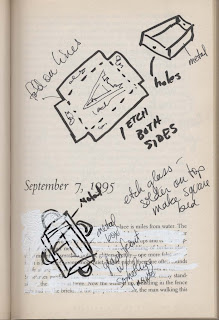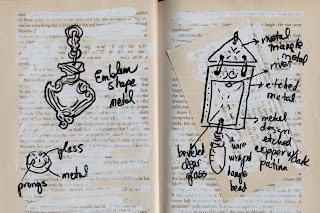
Novel Sketch Ideas
This is a page out of a more well-developed collage image, use it sometimes for handmade boxes.
Earlier, mentioned the twenty-five cent novel purchased from the library, and the sketches for the 'Specimen 08-50' piece. Thought scanning some pages to show how the piece starts, the development and thought process might be good to share here.
The novel was in bad shape, so there's no guilt involved in writing and drawing all in its pages. It's not such a good story either, so its refreshing to apply whiteout and use a gluestick to cover some of the writing. Then it's just a page for writing. Capturing those elusive ideas before they
 vanish. They seem to have a fast expiration period.
vanish. They seem to have a fast expiration period.
There's sometimes a hesitation to write or sketch in a pristine, blank white page sketchbook. The feeling that 'this is for posterity' or some other sense of marring the perfect clean white page with drawings that might not be right enough.
With this method, the page is already marred, has someone else's writing on it and it has been primed for a new purpose. It's very freeing, lots of writing surfaces that are easy to carry around, already 'aged' because the paper is old, and if the drawing doesn't work out, it's easy to rip the page right out. And kind of fun.
The first sketch on the left above was initial ideas about using the sheet brass to make the box, how the hanging loops might be attached, where the soldering might go and closing the lid with the glass.
Often the
 sketches are to capture shapes, or combinations of materials.
sketches are to capture shapes, or combinations of materials.Have a little zippered pouch of pens, pencils and my favorite tool for this type of sketching. Found it by accident and just love using it. It's a Pigma Brush with archival permanent black ink. It's like a flexible felt-tip marker, that acts like a paintbrush full of ink when marks are made with it. Thick and thin lines are easy, and it really flows. It's made by Sakura, can probably be found in any art supply store.
For thinner lines, using a Pilot Fine Tip.
The sketches are just that, rough drawings to capture the elusive ideas. The notes are important because the drawings are done so quickly they have no detail and later they don't provide enough information by themselves.
How do you keep your notes?
2 comments:
LLLYYNN, did really enjoy this entry. I love process, and to use your process, not as a stand alone, but a part of the piece is great. I can't wait to read the rest. dd
Hi, Diane,
Thanks for stopping by the blog, and for all the encouragement. Especially means a lot from a fine creative person like yourself!
LLYYNN
Post a Comment